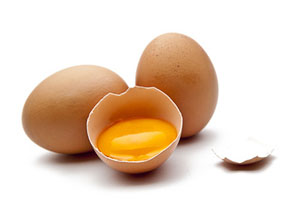All stages count in egg processing

Egg processing is an industrial and high tech operation which demands skills and knowledge. Achieving high quality liquid or powdered products is a matter of understanding the various steps in the process. A summing up of all the stages and the critical facts involved.
Holding
Eggs for processing must be of high quality to avoid excessive yolk breakage in egg-breaking machines. A fresh egg will have a thick white and an upstanding yolk. Over time, the egg white thins, and the yolk spreads and enlarges due to passage of water from the white through the yolk membrane into the yolk. This weakens the yolk. Eggs to be processed are usually held in refrigerated storage no longer than seven to ten days.
Equipment standards
Egg products are processed in sanitary facilities under a strict system of inspection. According to the American Egg Board (AEB), in the USA this is supervised by the USDA. Regulations require the use of E-3-A and 3-A Sanitary Standards and Accepted Practices for processing equipment. They are also applied to determine acceptance of the design of equipment commonly used in both the dairy and egg products industries. These standards were established by USDA and International Association for Food Protection. Some standards are adaptations of those of the Dairy and Food Industries Supply Association, Inc., and others are unique to the egg industry, such as those for egg-breaking equipment.
Breaking
Some shell egg processing facilities often have their own breaking facilities. Eggs are received, washed, rinsed, sanitised, and then candled (the process of using quartz halogen light to identify and remove eggs with imperfections). USDA’s Food Safety and Inspection Service (FSIS)-approved automated equipment enables operators to break, separate, and monitor for quality and imperfections 13,500 dozen (162,000) eggs per hour. Whole or separated eggs are mixed for uniformity and filtered to remove shell fragments, membranes, and chalazae. For quality assurance purposes, sample eggs may be hand-candled during each session to validate the mechanical candling results, and a sample amount of eggs are broken out and compared. The liquid egg product is filtered, mixed, and chilled before entering further processing stages.
Pasteurisation
Various times and temperatures are used for effective pasteurisation, depending on the product. All egg products are continuously monitored for pathogenic organisms. Pasteurised liquid egg products routinely contain less than 1,000 microorganisms per gram. Salmonella tests are run regularly by the egg products industry and FSIS. Only Salmonella-negative products can be sold. Yolk and whole egg products are pasteurised in their liquid form. Liquid egg white is pasteurised when sold as a liquid or frozen product. Dehydrated egg white with glucose removed is normally pasteurised by heat treatment in a hot room at 130°F (54.4°C) for seven days.
Refrigerated liquid egg products
Refrigerated liquid egg products may be transported directly from the breaking plant to the user in insulated thermal tank trucks or in portable refrigerated vats. For long hauls, mechanical refrigeration, liquid-carbon-dioxide, or liquid-nitrogen cooling systems may be used.
Liquid whole egg and yolk must be maintained below 40°F (4.4°C) and egg white below 45°F (7.2°C). They should be used on a first in, first out, basis.
Refrigerated liquid egg products can be kept at 40°F (4.4°C) for whole eggs and yolks or 45°F (7.2°C) for whites, unopened, for two to six days, depending on the microbial quality of the product. Refrigerated liquid egg products with extended shelf life should be stored according to the processor’s recommendations.
Frozen egg products
Frozen egg products are produced by filling a container with pasteurised chilled liquid egg and freezing in a blast freezer at a temperature of –10° to –40°F (–23.3° to –40°C). When thawed, frozen whole egg becomes quite fluid and easy to handle, but frozen raw yolk has a gelatinised consistency. However, when yolk is blended with sugar, corn syrup, or salt (usually at levels of 2% to 10%) before freezing, the product will become fluid when thawed.
Frozen egg products have a long shelf life when kept at less than 10°F (–12.2°C). Only as much as needed should be thawed in unopened containers under refrigeration or under cold running water and should be used as soon as possible after thawing.
Dried egg products
Dried egg products are usually produced by spray drying, although some egg white is dried on trays to produce a flake or granular form. Before the egg white is dried, glucose is removed. This produces dried egg white products with excellent storage stability. Whipping aids may be added to produce dried egg white products for good whipping properties. Sodium lauryl sulfate, an angel food cake volume enhancer, is added at a level of less than 0.1% by weight of the liquid prior to drying. Whenever long storage stability is required, glucose is removed from whole egg and yolk products before drying. Non-reducing carbohydrates such as glucose-free corn syrup and sucrose are added to some products to preserve their whipping properties and to improve their storage stability.
Egg white solids
As long as they are kept dry, egg white solids are stable during storage even at room temperature. Spray-dried egg white with glucose removed has an almost infinite shelf life.
Dried whole egg and yolk solids
Should be kept cool, less than 50°F (10°C), to maintain quality. Once containers of egg solids have been opened, they should be resealed tightly to prevent contamination and absorption of moisture. If dried eggs are combined with dry ingredients and held for storage, they should be sealed tightly in a closed container and stored in the refrigerator at 32° to 50°F (0° to 10°C). Reconstituted eggs should be used immediately.
Plain unstabilised whole egg products
Have a shelf life of about one month at room temperature and about a year at refrigerated temperatures. If stabilized, the shelf life increases to one year at room temperature. Unstabilised egg yolk solids have a shelf life of about three months at room temperature and more than a year at refrigerated temperatures. Stabilized egg yolk solids have a shelf life of about eight months at room temperature and over a year at refrigerated temperatures.
Speciality egg products
Should be kept refrigerated or frozen as recommended by the processor.
Source: www.aeb.org
Join 31,000+ subscribers
Subscribe to our newsletter to stay updated about all the need-to-know content in the poultry sector, three times a week. Beheer
Beheer











 WP Admin
WP Admin  Bewerk bericht
Bewerk bericht